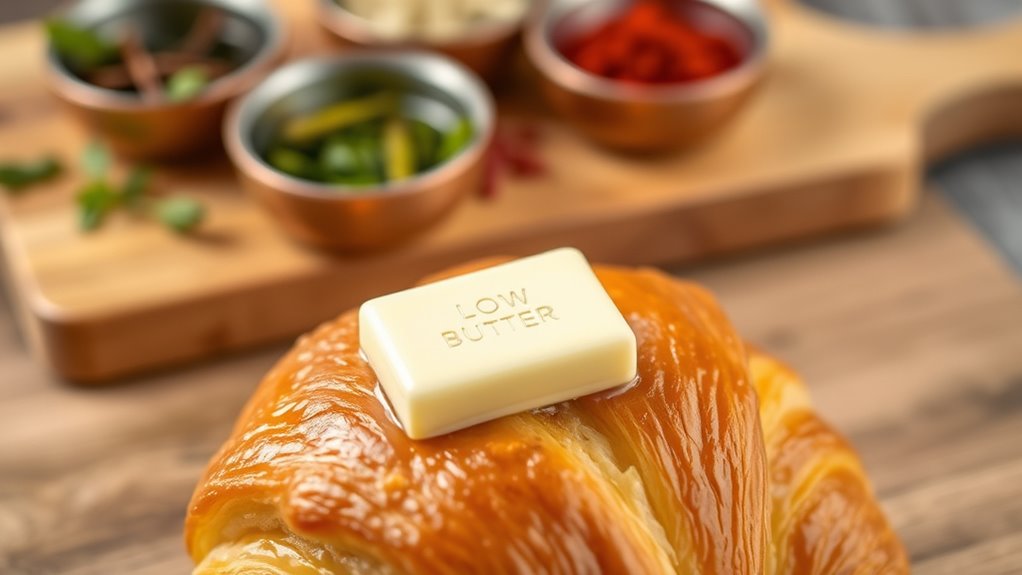Low-salt butter options let you reduce sodium intake without sacrificing flavor. They enhance your dishes while being suitable for health goals. However, some may contain additives, so it’s essential to check labels. You might notice differences in taste and texture compared to regular butter, and your taste buds may need time to adjust. With the right herbs and spices, you can create delicious meals. Stick around to discover more about maximizing your culinary experience with low-salt butter.
Key Takeaways
- Low-salt butter reduces sodium intake while preserving flavor, making it suitable for health-conscious consumers.
- It enhances dishes by allowing for flavor boosting with herbs and spices without overwhelming saltiness.
- Some low-salt options may contain additives; careful label reading is essential to ensure quality.
- Taste and texture can vary; adjusting to lower sodium may take time for some individuals.
- Using low-salt butter supports healthy cooking practices and can be a part of a balanced diet.

If you’re looking to reduce your sodium intake without sacrificing flavor, low-salt butter options can be a game changer. These alternatives provide a way to enjoy that rich, creamy taste you love while keeping your health goals in mind. When you choose low-salt or sodium-free butter, you’re not only cutting back on sodium but also opening up a world of culinary uses that can elevate your dishes.
One of the biggest advantages of low-salt butter is the enhanced flavor it brings without overwhelming your palate. Many brands have mastered the art of flavor enhancement, using natural ingredients to ensure that your meals still burst with taste. You can spread it on toast, use it in baking, or melt it over vegetables, and you’ll discover that it can enhance the flavors of your food without the extra sodium. Imagine preparing a savory garlic butter sauce for your pasta while knowing you’re taking care of your well-being.
Low-salt butter enhances flavor without the sodium, allowing you to enjoy rich taste in every dish.
However, it’s essential to contemplate the potential downsides when exploring low-salt options. Some low-salt butters may contain additives or preservatives that can affect the overall quality of the product. You’ll want to read labels carefully to avoid anything that doesn’t align with your dietary preferences. Additionally, you might notice a difference in texture or taste compared to regular butter. This isn’t necessarily a bad thing; just keep in mind that your taste buds may need some time to adjust.
When it comes to culinary uses, low-salt butter can be quite versatile. You can use it in sauces, marinades, and even desserts. The key is to balance flavors properly. Since you’re reducing sodium, you might want to incorporate herbs, spices, or citrus to boost the flavor profile of your dishes. For instance, mixing low-salt butter with fresh herbs can create a delicious compound butter that transforms your grilled meats or steamed vegetables into a gourmet experience. Additionally, opting for eco-friendly options in your cooking can provide health benefits while supporting sustainable practices.
Frequently Asked Questions
Can Sodium-Free Butter Still Enhance the Flavor of Dishes?
Yes, sodium-free butter can still enhance the flavor of dishes. It offers culinary versatility, allowing you to enjoy rich, creamy textures without overwhelming saltiness. By using herbs, spices, or other flavorings alongside sodium-free butter, you can elevate your meals while keeping them healthier. You’ll find that it complements various ingredients well, making it a great choice for sauces, spreads, or cooking. Experimenting with it can lead to delightful flavor discoveries!
Are There Any Health Risks Associated With Low-Salt Butter?
Low-salt butter generally poses minimal health risks for most people, but it’s crucial to take into account your overall dietary habits. While it reduces sodium intake, which can benefit heart health, you should still pay attention to other nutritional considerations, like calories and saturated fats. If you have specific health conditions, like kidney issues, it’s wise to consult a healthcare provider. Balancing your diet with various foods ensures you enjoy flavor without compromising health.
How Does Sodium-Free Butter Affect Baking Results?
Sodium-free butter can impact your baking results, especially in texture and melting point. Since it lacks salt, which enhances flavor and strengthens gluten, your baked goods might be softer and less structured. The melting point may also differ, potentially leading to greasier results. If you’re using sodium-free butter, consider adjusting other ingredients to maintain the desired texture and flavor in your recipes. Experimenting will help you achieve the best outcome!
Can I Find Sodium-Free Butter in Grocery Stores?
Yes, you can find sodium-free butter in grocery stores, often in the health food section or near regular butter. When you’re looking for butter substitutes, check labels carefully to verify they’re sodium-free. These options not only provide the creamy texture you want but can also enhance the flavor of your dishes. Experimenting with different brands might help you find the perfect fit for your cooking and baking needs!
What Are the Best Brands for Low-Salt Butter?
When you’re looking for the best brands for low-salt butter, consider trying artisanal brands like Kerrygold or Plugra. They offer rich flavors while keeping sodium levels low. If you prefer organic options, look for brands like Organic Valley or Horizon Organic; they provide great taste without excessive salt. Always check the labels to find the right balance of flavor and health. You’ll discover delightful choices that suit your dietary preferences!
Conclusion
In choosing sodium-free and low-salt butter options, you’re making a choice as wise as a seasoned chef selecting the finest ingredients. These alternatives can help manage your sodium intake while still enhancing your dishes with flavor. However, it is crucial to be mindful of the potential trade-offs in taste and texture. Ultimately, balancing health benefits with culinary satisfaction will lead you to the right choice for your diet and cooking preferences. Enjoy experimenting with these options!









